
A crusty, oozing rash is erupting along the crest of your horse’s neck and it itches so much that he’s rubbing his mane out. He has a raging case of sweet itch, just one of many allergic reactions that can make horses miserable and interfere with performance. What can you do to help him?
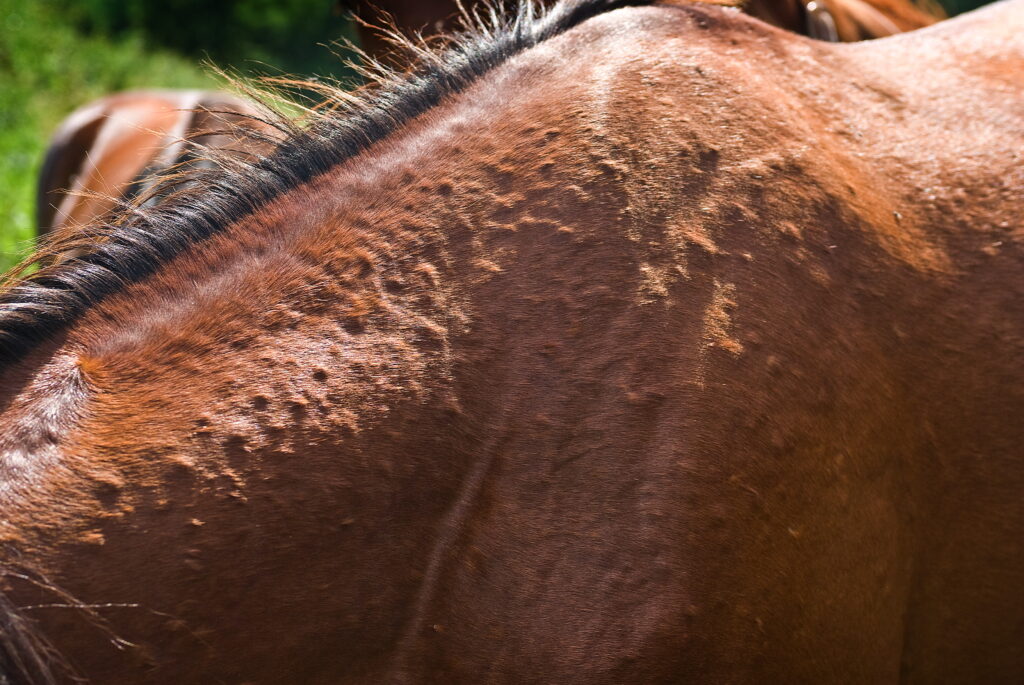
“Allergies are not curable, but they are manageable,” says Christine Rees, DVM, a board-certified veterinary dermatologist based in McKinney, Texas. Here, Dr. Rees helps explain these reactions, their causes and some strategies for diagnosing and treating allergic conditions.
As an Amazon Associate, Practical Horseman may earn an affiliate commission when you buy through links on our site. Product links are selected by Practical Horseman editors.
Allergic reactions in horses can be mild and passing, severe and life-threatening or anything in between. Triggers range from airborne particles to vaccines. But the direct cause of all these reactions is the horse’s immune system, the system that defends him from disease. The immune system’s job is to identify foreign substances and wipe out those that cause harm. An allergic reaction represents a false alarm—the system tags something harmless as a threat and mounts a response that damages the horse’s own body tissues.
Signs
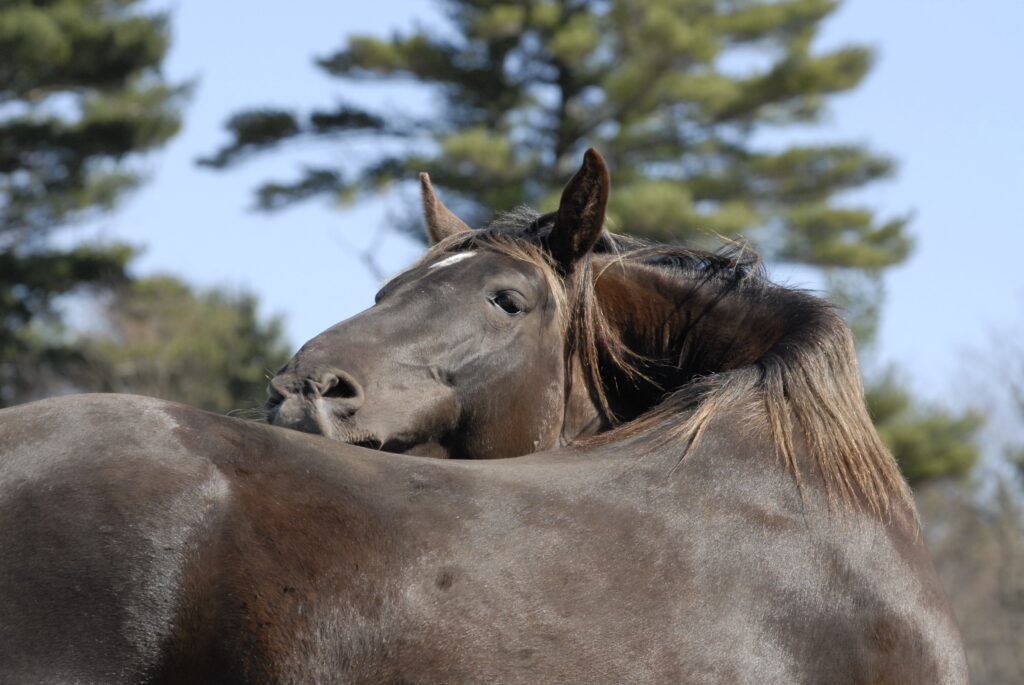
Immune responses are complex and involve many factors. They can be immediate or delayed, so allergy signs can appear minutes, hours or as much as two days after exposure to a trigger. Many reactions involve release of the chemical histamine, which produces swelling and other signs of inflammation. The skin is a common site for this, so signs of allergy often show up there. Among the most common signs are these:
• Hives are raised swellings in the skin, soft enough to indent under finger pressure. They typically appear first as a few small lumps on the horse’s neck or shoulders, but they can multiply and grow into big welts and spread across his chest, sides and other areas.
• Itching (pruritus) accompanies many skin reactions. It’s the sensation that makes the horse rub, lick or bite his skin. An itchy rash is typical of reactions caused by insect bites. As the horse rubs and scratches the area to get relief, hair falls out and sores and scabs develop. Sometimes a secondary infection sets in.
Skin reactions are the main focus of this article, but allergies can produce other signs. Swelling may appear around the eyes and muzzle or it may be internal. Coughing, labored breathing and other respiratory signs can develop when a reaction causes internal swelling that narrows breathing passages. Respiratory allergies are thought to play a major role in the development of recurrent airway obstruction (RAO)—heaves—which has a lot in common with human asthma.
When the horse mounts an allergic response, he becomes hypersensitized to the specific substance that triggered the response, called the allergen. His immune system adapts and becomes better prepared to defend against it. T-cells, specialized white blood cells, patrol for that allergen. When they spot it, they activate other immune cells that produce antibodies and inflammatory chemicals. The horse will likely respond faster and more strongly the next time he’s exposed to that allergen, so allergies often become more serious with repeated exposure.
Repeated exposure increases the risk of a rare but potentially fatal allergic reaction called anaphylaxis. This is a systemic reaction with sudden and extreme effects—the horse’s blood pressure drops, he struggles to breathe and he may go into shock. A veterinarian may be able to reverse the reaction by administering epinephrine (which raises blood pressure) and a corticosteroid such as dexamethasone (which reduces internal swelling), but this must be done quickly.
Call your veterinarian at once if the horse seems distressed, has difficulty breathing or has severe swelling around his muzzle that could restrict airflow. Even if the signs don’t seem that urgent, put in a call if they don’t improve in 24 hours or if the reaction recurs.
Triggers
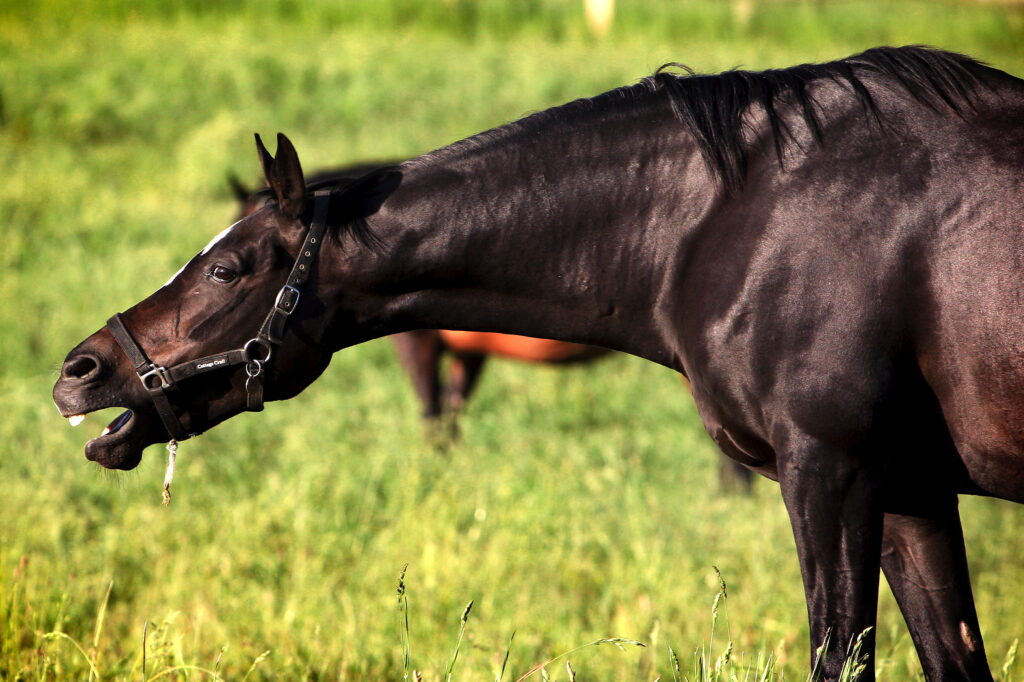
Knowing what triggered your horse’s allergic reaction—even if it’s just a mild case of hives—will help you protect him from repeat episodes. But finding the cause can be a challenge because signs typical of many allergies aren’t so different from the signs of skin infections, respiratory diseases and other health problems. The fact that signs can appear hours after exposure to the allergen makes the task even harder. If your horse comes in from the pasture covered in hives, you won’t know what triggered the outbreak or even when he was exposed.
The horse’s clinical signs and history, along with knowledge of local and seasonal allergens in your area, can help determine which allergens could be significant, Dr. Rees says. Triggers for skin reactions fall into these groups:
Insect bites. Swelling around a lone insect bite is a normal inflammatory response, but an itchy rash or a case of hives is more likely a true allergic response. The oozing rash characteristic of sweet itch, or summer eczema, is an allergic reaction to the bites of tiny Culicoides midges, which many people call no-see-ums. Proteins in the saliva of the midges trigger the reaction in the horse. Sweet itch is more common in some breeds (Icelandics, Welsh and Shetland ponies, Friesians), and Dr. Rees says that researchers have identified genetic factors that increase risk.
Environmental allergens. Weeds and grasses, along with insects, cause the most trouble for horses, Dr. Rees says. Common environmental allergens include molds and dust mites as well as pollen from cocklebur, ragweed and various other plants. Some horses are allergic to pollen from Bermuda grass, which is widespread in southern states and is sometimes used for pasture.
“Allergens are different in different areas of the country, so a horse that has allergies in Texas may not have allergies on the East Coast,” Dr. Rees says. A hypersensitive horse may develop respiratory symptoms—but, even though these allergens are inhaled, hives and other skin reactions are common. The term for this condition is atopic dermatitis. “Atopic dermatitis is thought to be an inherited or genetic problem in horses, as in people and other animal species,” she says.
Contact allergens. These are substances that trigger hives or other skin symptoms through contact with the horse’s skin. The allergen may be an ingredient in a shampoo, coat conditioner, fly spray or other topical product—something as benign as lanolin, which is fine for most horses but a problem for a hypersensitive few. It could be something in stall bedding or a plant that the horse rolled in or rubbed against in the pasture.
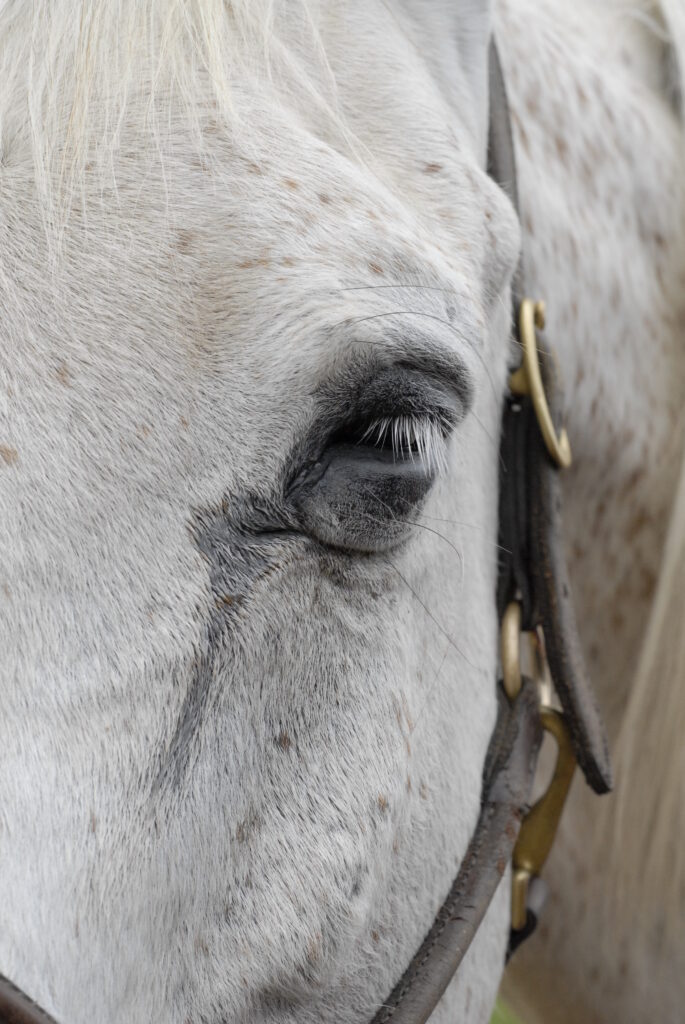
Medications. Medications and vaccines that most horses tolerate well sometimes trigger reactions in certain other horses. Signs can range from hives to anaphylaxis. Vaccine reactions are sometimes caused by adjuvants, ingredients added to vaccines to enhance the immune response to the vaccine. Hives and other skin signs are common in these reactions regardless of how the medication is administered (orally, or by injection into muscle or vein). Re-exposure to the drug produces more severe signs in a shorter period.
Food. Food allergies are much less common in horses than in people. Horses can have trouble digesting some foods, and the world is full of plants with toxic substances that can produce everything from photosensitivity to kidney failure in horses—but those are not allergic reactions. There have been reports of horses breaking out in hives after eating alfalfa hay, barley or some other feed. However, it’s often not clear if the hives are a reaction to mold or some other contaminant rather than to the hay or feed itself.
Clues
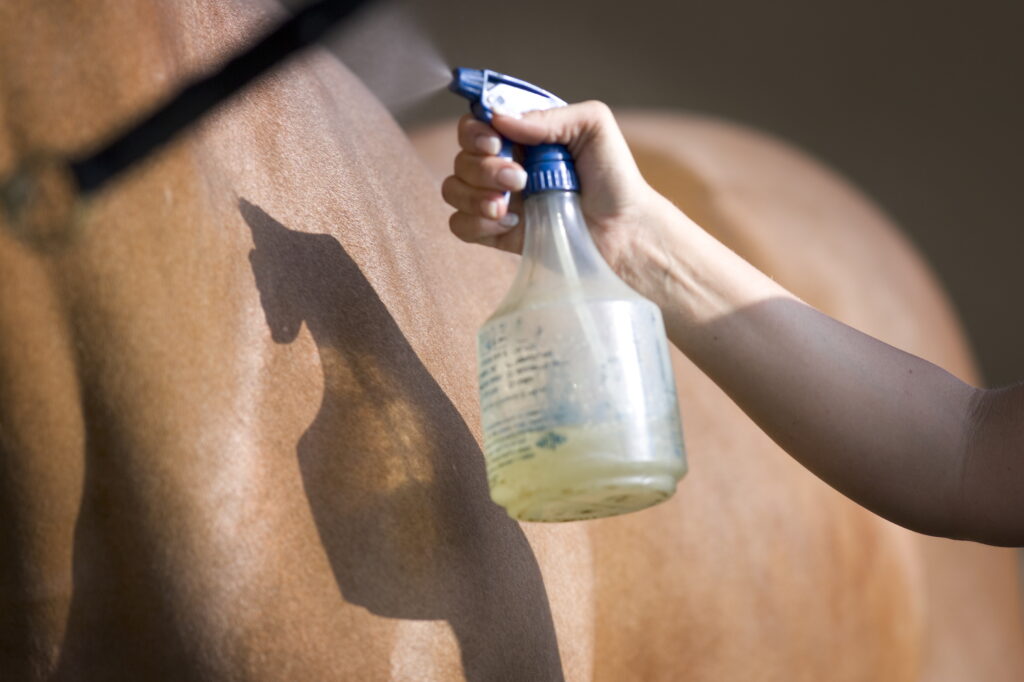
Each of the major allergen groups contains scores of potential triggers. You and your veterinarian will need to do some detective work to find out which ones are causing your horse’s misery. Start by answering these questions:
What’s new in his life? Anything new—a new grooming product, a new supplement—moves to the top of the list. If you’ve moved the horse, he may be reacting to new environmental allergens. Environmental allergies usually show up within six months of first exposure, Dr. Rees says, although sometimes they take much longer to appear.
When do signs appear? Keep records noting when and where your horse’s reaction occurs. Environmental allergies are often seasonal, depending on what insects are active and what plants are blooming. If your horse rubs his mane out in the spring, Culicoides should top the list of suspects. If hives erupt in September, ragweed pollen could be the cause. But you wouldn’t suspect either allergen to trouble your horse during a snowy January when the midges aren’t active and the ragweed is dead. (Your county Cooperative Extension office can help you identify the seasonal risks in your area.)
What do the signs show? As you might guess, contact reactions usually show up first on the part of the horse’s body where contact occurred. In addition, “Certain insects prefer certain areas of the body,” Dr. Rees says. For example, Culicoides midges typically bite the horse along the crest of the neck, around the dock or on the belly. However, she notes, other allergies can also cause this type of skin pattern.
Does elimination stop the reaction? If your horse breaks out in hives after you try out a different fly repellent, stop using the product and see if his signs disappear. You can identify a food allergy through a process of elimination, too. Change the horse’s hay and withdraw his grain, supplements and treats. If the problem clears up, add the items back one at a time to see if any cause a recurrence. But if the problem persists even when you change his diet, you can probably rule out food allergy as a cause.
Tests

Environmental allergens are especially hard to identify because the sources often aren’t at hand and can’t be eliminated. Mold spores, dust and pollen are everywhere and can drift for miles on the wind. Dr. Rees says allergy testing is useful in these cases.
“The intradermal allergy test, or skin test, is the gold standard,” she says. This test measures both immediate and delayed (cell-mediated) reactions. It’s usually done by veterinary dermatologists at large clinics. The horse is sedated, an area on the side of the neck is clipped and small dots of different allergens are injected intradermally (just under the skin). To help in gauging the extent of any reaction, small amounts of histamine (as a positive control) and saline or sterile water (as a negative control) are also injected. Then the sites are evaluated at intervals. “I have found it useful to take readings at 15 minutes, 30 minutes and 4 to 6 hours. The reaction pattern varies with the horse. Some horses react at 15 minutes only, others may just react at 4 hours and still other horses react at all time periods,” Dr. Rees says.
The test results can provide answers, but a positive reaction to a specific allergen doesn’t always mean that substance is the cause of the horse’s problem. The results have to be put in context. The answer has to fit the history (it’s something that the horse was or could have been exposed to) and the physical signs. The final check is to see whether eliminating it (if that’s possible) solves the problem.
Blood can also be tested for allergies. This is simpler—blood is drawn and sent off to the lab. However, “The blood allergy test is not as sensitive and measures immediate reactions only,” Dr. Rees says, and the results from skin allergy tests often vary from blood test results.
Costs vary considerably, she notes: Depending on the number of allergens tested, regional price differences and other factors, you can expect to pay from $250 to $500 for either the skin test or the blood test. This doesn’t include fees for examination and treatment, sedation or shipping.
Testing is less useful for insect-bite hypersensitivity because the results are often unclear. Blood tests offered for equine food allergies are unreliable.
Strategies
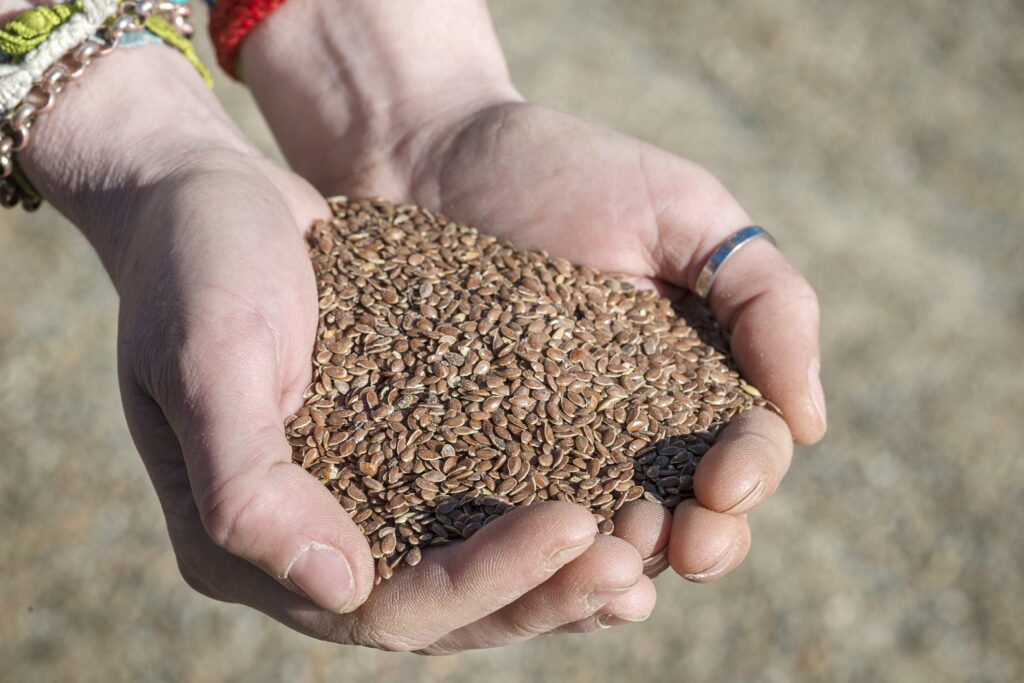
Topical medications and shampoos can help calm skin reactions, Dr. Rees says. Helpful ingredients include oatmeal, aloe, pramoxine and steroids such as hydrocortisone. Supplementing feed with omega-3 fatty acids may help; a study at Guelph University in Canada found that adding flaxseed, a rich source of omega-3s, reduced reactions to Culicoides bites. Your veterinarian can prescribe systemic medications such as dexamethasone or antihistamines. (If you show, you should be aware that these drugs are barred or restricted by the U.S. Equestrian Federation and other sport organizations.)
Medications and supplements can make your allergic horse more comfortable, but “this is a Band-Aid treatment,” Dr. Rees says. You need a way to block these reactions and protect your horse, and that will depend on the type of allergy he’s dealing with. There are two basic strategies:
Elimination. The most direct strategy is to banish the allergen from your horse’s life. If he reacts to a certain product, don’t use it. If a medication causes the reaction, work with your veterinarian to find a substitute. If biting insects are the problem, focus on fly control:
• Keep horses who are sensitive to Culicoides in during early morning and evening hours, the times when these insects are most active.
• “Fans in the stalls are useful,” Dr. Rees says, as these midges are weak fliers and can’t navigate a strong breeze.
• Use fly masks, fly sheets and fly repellents labeled for equine use when horses are turned out.
• Promptly pick up manure, trampled hay and other materials that can provide breeding sites for biting flies.
• Drain standing water and stock ponds and water tanks with mosquito fish or other fish that eat insect larvae.
• Check out other approaches, like feed-through fly control and tiny fly-predator wasps, to see if they might fit your situation.
Immunotherapy. Your horse can’t live in a filtered air bubble, so environmental allergens are practically impossible to eliminate. For skin reactions caused by these allergens, immunotherapy (also called hyposensitization) may make sense.
“Allergy-specific immunotherapy based on allergy testing is the most natural way to take an abnormal, allergic immune system and make it normal,” says Dr. Rees. The results of allergy tests are used to develop custom injections containing small amounts of the troublesome allergens. With repeated injections, the horse becomes less sensitive to those substances. Then, to keep the allergy at bay, the horse will need regular maintenance shots.
There are various treatment protocols, Dr. Rees says. Treatment typically starts with a series of low-dose injections given every few days and then the interval between shots is lengthened as the dose is increased. For maintenance, she finds that many horses do well with 1-cc injections every two to three weeks. “Daily allergy drops have recently been used in some mules and horses with variable results,” she adds. No standard concentration or schedule exists for these drops, which are placed under the tongue.
Success rates reported for allergy shots range from 60 to 80 percent. It takes time for the treatment to show results and a lot hinges on the accuracy of the tests used to formulate the injections. Testing may identify some but not all of the allergens that trouble a horse, so he still reacts to the unidentified triggers. “I have had several horses that were blood-tested for allergies and did not respond to immunotherapy, but they did well when they were skin-tested and immunotherapy was based on the skin-test results,” says Dr. Rees.
Depending on the number of allergens your horse is treated for and the frequency of his shots, the cost of immunotherapy can add up to $2,000 a year. But when allergies make a horse miserable or limit his performance, the treatment can make a big difference.
This article originally appeared in the July 2016 issue of Practical Horseman.








